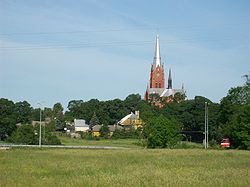Ramygala
Ramygala | |
|---|---|
City | |
 Panorama of Ramygala | |
| Country | |
| Ethnographic region | Aukštaitija |
| County | |
| Municipality | Panevėžys district municipality |
| Eldership | Ramygala eldership |
| Capital of | Ramygala eldership |
| First mentioned | 1503 |
| Granted city rights | 1957 |
| Population (2005) | |
| • Total | 1,678 |
| Time zone | UTC+2 (EET) |
| • Summer (DST) | UTC+3 (EEST) |
Ramygala (, literally "quiet end") is a small city in Lithuania. It is located some 24 km (15 mi) south from Panevėžys on the banks of the Upytė River, a tributary to the Nevėžis River. According to 2005 estimate, it had just below 1,700 residents.
History
The name "Ramygala" was first mentioned in the 13th century. In 1370 the place suffered from the Teutonic Knight attack. Sometime before 1500 the first church was built and in 1503 the name "Ramygala" was used to refer to a town. Since then Ramygala slowly grew. Few years later it had a manor, and at the end of the 16th century it received a privilege to host fairs. Unlike many other towns in Lithuania, Ramygala did not belong to a noble family but rather to Vilnius Cathedral and later to Vilnius University.
In 1781 the town established a parish school next to a new church after the old one was destroyed by fire. The school grew and expanded significantly in the 20th century. It built two new school buildings and a dorm. In 2005 it was named Ramygala Gymnasium. The school hosts a small museum dedicated to the local history and traditions. A new Neo Gothic church was built in 1897-1914. It has 3 aisles and 3 altars. It features only one bell tower. The tower was damaged during World War II, but was rebuilt in the 1950s.
Administration
Since the second half of the 18th century, Ramygala was administrative center of a valsčius. After the administrative reform by the Soviet authorities in 1950, the town became a capital of a raion (Lithuanian: rajonas). In 1957 it received city rights. In 1962 Ramygala lost the status of the capital of a raion. Now it is a center of an eldership, the smallest administrative division in Lithuania. It has a small hospital and a library.
Famous people
- The Venerable Mother Maria Kaupas (1880-1940), nun and founder of the Sisters of Saint Casimir
- Mykolas Vrubliauskas (1919–1998), ceramics artist
- Saulius Mykolaitis (1966–2006), actor
Famous places
Bison Paddock of Pašiliai
Till the sixteenth century aurochs were widespread throughout Europe. They lived in sparse deciduous and mixed forests, steppes, and mountains. Agricultural development, rapidly growing number of people and intensified hunting displaced these animals to the areas little adapted for their lives, to secluded forests, where aurochs began to decline rapidly. It is stated that the last wild auroch was hunted in 1919 in Poland. Nature lovers restored the bison population freeing them from the zoo bars. Currently about 50 aurochs are now living in Lithuania, some in the farm while others run free in the wild. The name of each auroch begins with the symbolic letters GI – Girinis, Gintaras, Girbaite and others.[1]
References
- Jonas Zinkus; et al., eds. (1987). "Ramygala". Tarybų Lietuvos enciklopedija (in Lithuanian). Vol. III. Vilnius, Lithuania: Vyriausioji enciklopedijų redakcija. pp. 500–501.
- "Ramygalos seniūnija" (in Lithuanian). Panevėžys district municipality. Retrieved 2006-12-10.
- "Ramygalos Šv. Jono Krikštytojo parapija" (in Lithuanian). Panevėžys Diocese. Retrieved 2006-12-10.
- Bison paddock of Pašiliai


